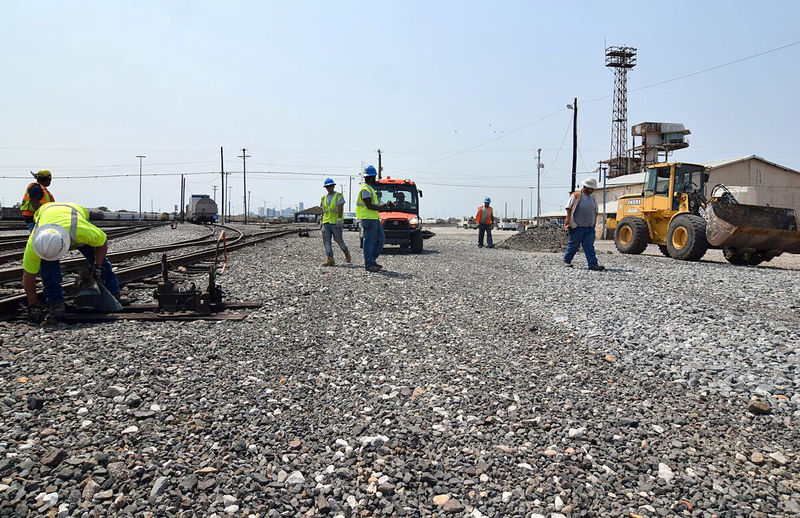By Eric M. Johnson and Nick Carey
(Reuters) - A week before Hurricane Harvey walloped Houston, workers for Union Pacific Corp (N:UNP) began moving rail cars out of the railroad's Englewood switching yard near downtown and brought in enough generators to fill 70 tractor trailers to keep signal systems running.
Union Pacific has tried to make the yard, a crucial hub in its southeastern Texas network, more flood-resistant, modifying drainage systems and raising tracks. But Harvey's torrential rains turned the facility into a "lake," Union Pacific's CEO Lance Fritz told Reuters this week during a visit to the now-dry yard.
The Englewood yard flood was part of widespread problems caused by catastrophic floods in Houston and southeastern Texas that disrupted Union Pacific's service for two weeks, and inflicted millions of dollars' worth of damage that is not covered by insurance, Fritz said.
But the price of flood-proofing the hub could be even greater.
"There's not much we're going to be able to do that we'd be willing to do at the price it would cost," Fritz said.
Union Pacific's challenge is shared by other transport companies like FedEx Corp (N:FDX) and Old Dominion Freight Line Inc (O:ODFL) that have built substantial hubs to serve the energy and agricultural industries, and transport consumer goods across sprawling Houston, America's fourth-largest city.
Harvey brought freight shipments to a virtual standstill after it came ashore on Aug. 25 as the most powerful hurricane to hit Texas in more than 50 years, killing an estimated 50 people and causing as much as $180 billion in damage.
Union Pacific is working with scientists at the U.S. National Oceanic and Atmospheric Administration (NOAA) to figure out which spots along its 32,100-mile (51,660 km) rail network are most vulnerable to catastrophic water flows from storms, Fritz said.
"Then we're attacking those spots by creating more culverts, raising the railroad up - whatever it looks like needs to happen in order to maintain traffic flow," Fritz said.
As of Thursday, the majority of Union Pacific's rail service had been restored, the company said.
After a series of floods in the region over the past several years, freight movers had taken steps to decrease their risk. But Harvey is forcing a recalculation of those risks.
FedEx spent a year building flood protection features into a $300 million package-sorting hub it opened last month in suburban Houston, raising the entire site up 8 feet (2.4 m), digging drainage systems and widening a nearby creek.
Despite FedEx's engineering efforts, Harvey still swamped roads and highways leading in and out of its Cypress, Texas, facility, a critical nexus for funneling U.S. shipments throughout Texas and the broader U.S. Gulf Coast to Florida.
Hundreds of employees could not return to the site for days, and the facility suffered minor leaks and electrical damage from several brownouts, meaning it could be weeks before sorting systems can again handle averages of 180,000 to 250,000 packages daily, said a FedEx employee with direct knowledge of the situation.
As FedEx expands its distribution network, designers and engineers weigh the potential impact of weather-related events on service operations, FedEx spokeswoman Meredith Miller said.
She declined to discuss specifics about its facilities, citing confidentiality, but said the company was delaying the startup of full operations until later in September as a safety precaution for workers.
MORE CAPACITY
Several transportation companies, including Old Dominion Freight Line, say the Houston area is too vital to their customers to reduce their footprints.
Old Dominion's senior vice president of operations, Dave Bates, said in an interview this week the carrier plans to open a new 80-door terminal in mid-November near the William P. Hobby Airport in a location it sees as less vulnerable to flooding. Old Dominion is the fourth-largest U.S. less-than-truckload carrier, or operator that consolidates smaller freight loads onto a single truck.
The new terminal, which will add twice the capacity to an existing Houston terminal, will be built with a ramp leading from ground level several feet up to its dock, with expanded door openings, sheltering its expensive rigs from flood waters, Bates said.
Old Dominion's current facility has a similar ramp and although its tractors were saved, about 200 trailers in its yard had wheels fully submerged by floodwater and workers have spent days painstakingly draining water from the axles.
"It's the cost of doing business in Houston," Bates said by phone. "You just suck it up, and you do it."
(Graphic on Harvey's energy impact: http://fingfx.thomsonreuters.com/gfx/rngs/STORM-HARVEY-ENERGY-INFRASTRUCTURE/010050M21F9/index.html)
(Graphic on Hurricane costs: http://fingfx.thomsonreuters.com/gfx/rngs/STORM-HARVEY-RELIEF/010050LZ1F3/index.html)
